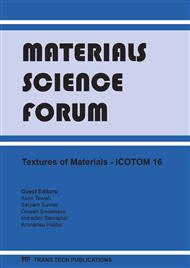[1]
O. Bouaziz, S. Allain, C.P. Scott, P. Cugy, D. Barbier, High manganese austenitic twinning induced plasticity steels: A review of the microstructure properties, Current Opinion Solid State Mater. Sci. in press (2011).
DOI: 10.1016/j.cossms.2011.04.002
Google Scholar
[2]
I. Gutierrez-Urrutia, S. Zaefferer, D. Raabe, The effect of grain size and grain orientation on deformation twinning in a Fe–22 wt. % Mn–0. 6 wt. % C TWIP steel, Mater. Sci. Eng. A 527 (2010) 3552-3560.
DOI: 10.1016/j.msea.2010.02.041
Google Scholar
[3]
D. Raabe, M. Sachtleber, Z. Zhao, F. Roters, S. Zaefferer, Micromechanical and macromechanical effects in grain scale polycrystaI plasticity. Experimantion and simulation, Acta Mater. 49 (2001) 3433-3441.
DOI: 10.1016/s1359-6454(01)00242-7
Google Scholar
[4]
I. Gutierrez-Urrutia, D. Raabe: submitted to Acta Materialia (2011).
Google Scholar
[5]
I. Gutierrez-Urrutia, S. Zaefferer, D. Raabe, Electron channeling contrast imaging of twins and dislocations in twinning-induced plasticity steels under controlled diffraction conditions in a scanning electron microscope, Scripta Mater. 61 (2009).
DOI: 10.1016/j.scriptamat.2009.06.018
Google Scholar
[6]
A.J. Wilkinson, P.B. Hirsch, Electron diffraction based techniques in scanning electron microscopy of bulk materials, Micron 28 (1997) 279-308.
DOI: 10.1016/s0968-4328(97)00032-2
Google Scholar
[7]
M.A. Crimp, Scanning Electron Microscopy Imaging of Dislocations in Bulk Materials, Using Electron Channeling Contrast, Microscopy Research Technique 69 (2006) 374-381.
DOI: 10.1002/jemt.20293
Google Scholar
[8]
A. Weidner, S. Martin, V. Klemm, U. Martin, H. Biermann, Stacking faults in high-alloyed metastable austenitic cast steel observed by electron channelling contrast imaging, Scripta Mater. 64 (2011) 513-516.
DOI: 10.1016/j.scriptamat.2010.11.028
Google Scholar
[9]
V. Gerold, H.P. Karnthaler, On the origin of planar slip in F.C.C. alloys, Acta Metall. 37 (1989) 2177-2183.
DOI: 10.1016/0001-6160(89)90143-0
Google Scholar
[10]
S.I. Hong, C. Laird, Mechanisms of slip mode modifications in f. c. c. solid solutions, Acta Mater. 38 (1990) 1581-1594.
DOI: 10.1016/0956-7151(90)90126-2
Google Scholar
[11]
B. Bay, N. Hansen, D.A. Hughes, D. Kuhlmann-Wilsdorf, Overview Nº 96. Evolution of F.C.C. deformation structures in polyslip, Acta Metall. Mater. 40 (1992) 205-219.
DOI: 10.1016/0956-7151(92)90296-q
Google Scholar
[12]
D. Canadinc, H. Sehitoglu, H.J. Maier, Y.I. Chumlyakov, Strain hardening behavior of aluminum alloyed Hadfield steel single crystals, Acta Mater. 53 (2005) 1831-1842.
DOI: 10.1016/j.actamat.2004.12.033
Google Scholar
[13]
D. Canadinc, H. Sehitoglu, H.J. Maier, The role of dense dislocation walls on the deformation response of aluminum alloyed hadfield steel polycrystals, Mater. Sci. Eng. A 454-455 (2007) 662-666.
DOI: 10.1016/j.msea.2006.11.122
Google Scholar
[14]
D. Kuhlmann-Wilsdorf, Theory of plastic deformation: -properties of low energy dislocation structures, Mater. Sci. Eng. A 113 (1989) 1-41.
DOI: 10.1016/0921-5093(89)90290-6
Google Scholar
[15]
T. Mori, H. Fujita, Effect of dislocation structure on the flow stress in Cu-3at. %Al single crystals, Phil. Mag. A 46 (1982) 91-104.
DOI: 10.1080/01418618208236210
Google Scholar
[16]
N. Hansen, X. Huang, Microstructure and flow stress of polycrystals and single crystals, Acta Mater. 46 (1998) 1827-1836.
DOI: 10.1016/s1359-6454(97)00365-0
Google Scholar
[17]
J.P. Hirth, J. Lothe, Theory of dislocations, John Wiley & Sons, (1982).
Google Scholar
[18]
L. Bracke, L. Kestens, J. Penning, Direct observation of the twinning mechanism in an austenitic Fe–Mn–C steel, Scripta Mater. 61 (2009) 220-222.
DOI: 10.1016/j.scriptamat.2009.03.045
Google Scholar
[19]
G. Winther, D. J. Jensen, N. Hansen, Dense dislocations walls and microbands aligned with slip planes. Theoretical considerations, Acta Mater. 45 (1997) 5059-5068.
DOI: 10.1016/s1359-6454(97)00168-7
Google Scholar


